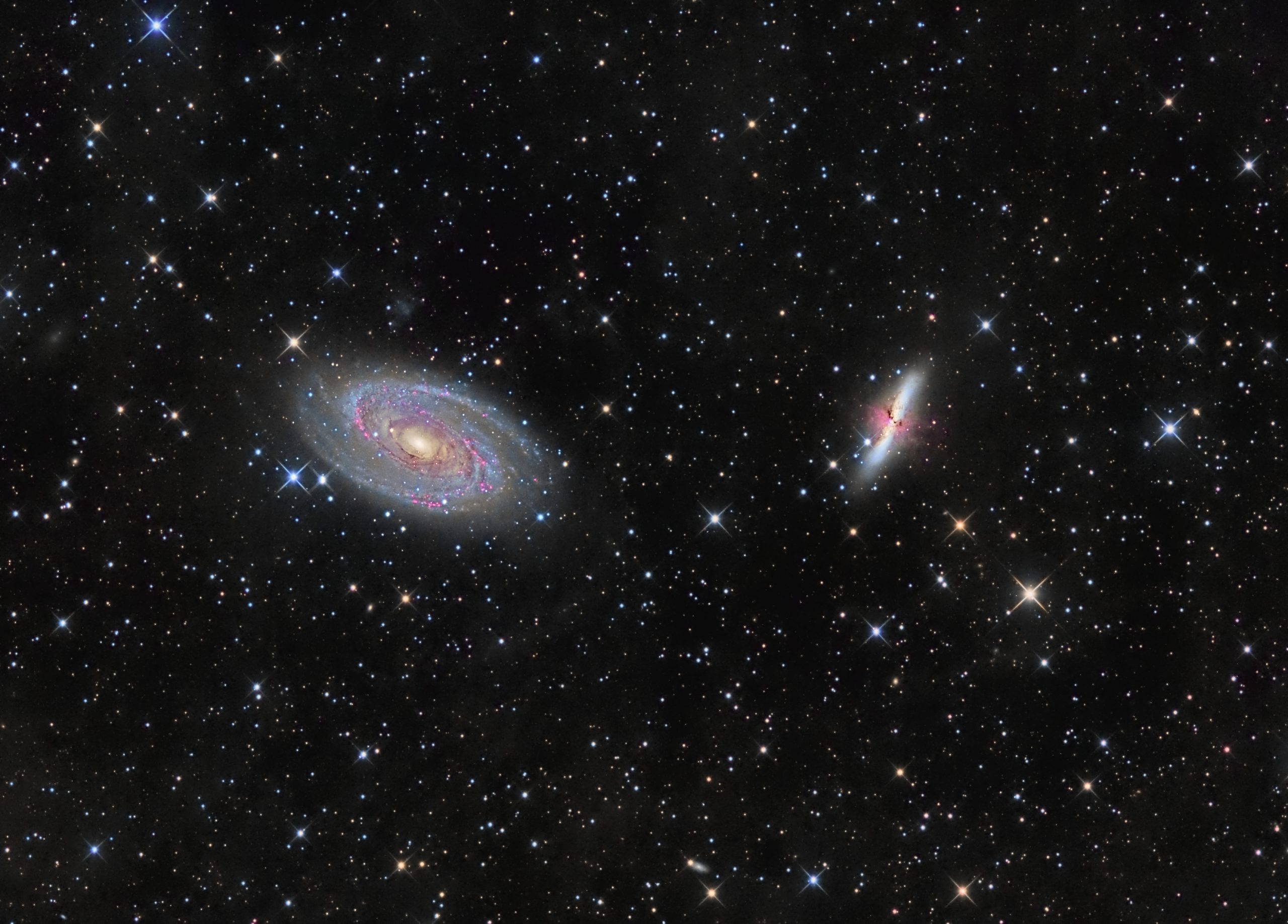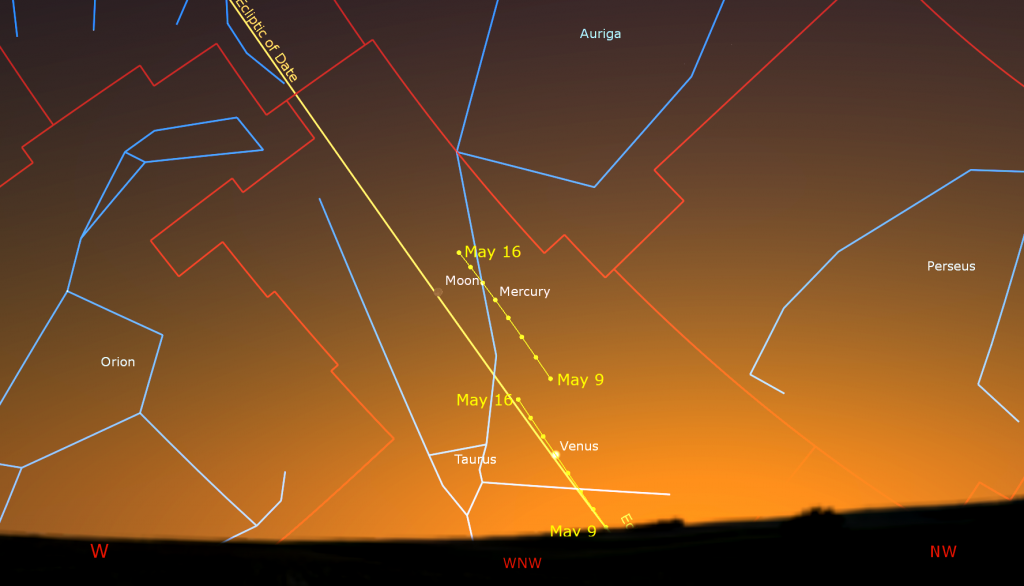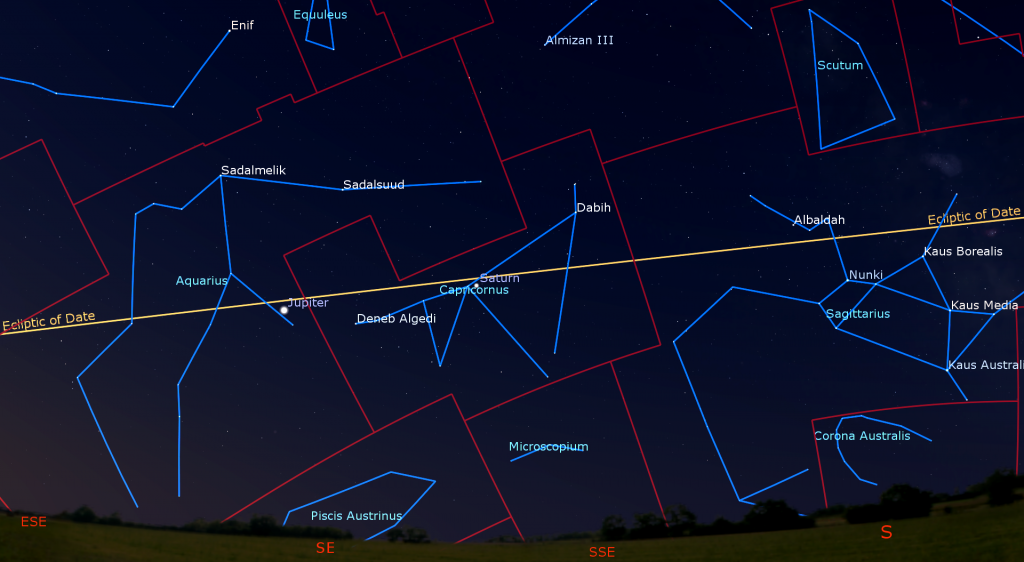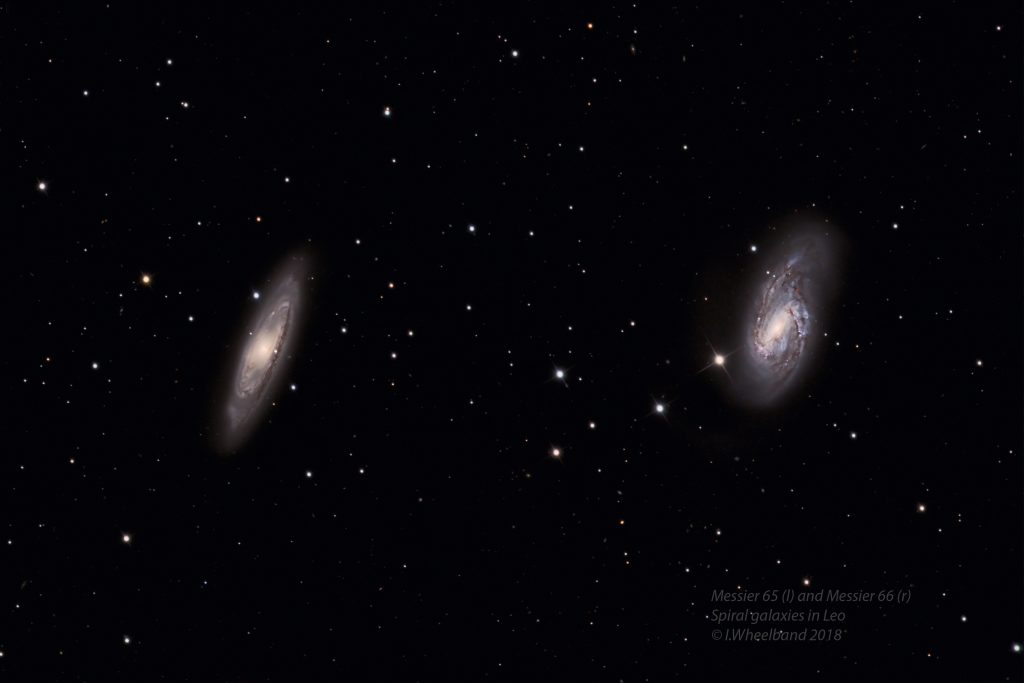More Dark Sky Nights before the Crescent Moon Passes Planets in Evening and Stops Some Starlight!

The prominent galaxies Messier 81 or Bode’s Nebula (left) and Messier 82 or the Cigar Galaxy (right) are located near the Big Dipper’s bowl in the northern sky. This image by AstroDoc Ron Brecher of Guelph, Ontario from February, 2017 spans about 1.5 degrees, or three full moon diameters. Messier 81 is large and bright enough to see through a good-sized telescope in suburban skies. Messier 82’s burst of central material makes it a peculiar-type galaxy. ROn’s images are hosted at www.astrodoc.ca
Happy Mother’s Day, Stargazers!
Here are your Astronomy Skylights for the week of May 9th, 2021 by Chris Vaughan. Feel free to pass this along to your friends and send me your comments, questions, and suggested topics. You can also follow me on Twitter as @astrogeoguy! Unless otherwise noted, all times are expressed in Eastern Time. To subscribe to these emails please click this MailChimp link.
I can bring my Digital Starlab portable inflatable planetarium to your school or other daytime or evening event, or teach a session online. Contact me through AstroGeo.ca, and we’ll tour the Universe, or the Earth’s interior, together!
The moon will pass the sun on Tuesday and be back in view in the western post-sunset sky after mid-week – leaving much of this week nice and dark for spring galaxy-viewing. While the crescent moon climbs the western sky, it will pass Venus, Mercury, and Mars, and end this week by occulting a star in Gemini. Mercury’s recent terrific apparition will peak at greatest elongation next Sunday. Early risers can enjoy the bright gas giant planets. Read on for your Skylights!
The Moon
If you live in the southern hemisphere, or not too far from the equator, you should be able to see an extremely thin crescent moon shining over the eastern horizon before sunrise on Monday morning. If you live along mid-northerly latitudes, however, the moon will be far less obvious – because the ecliptic (and the moon’s orbital plane) will make a very shallow angle with respect to your horizon. The moon’s angle from the sun (or elongation) of 15° on Monday will be the same wherever you live on Earth – but a near-vertical ecliptic will keep the sun well below the horizon while the moon shines vertically above it, and a shallow ecliptic will place the moon almost beside the rising sun. Don’t use binoculars or telescopes to hunt for the moon unless the sun is completely below the horizon.
The moon will be hidden from view for everyone on Tuesday. It will officially reach its new phase at 3:00 pm EDT. That’s 12:00 pm PDT and 19:00 Greenwich Mean Time. While new, the moon is travelling between Earth and the sun. Since sunlight can only shine on the far side of the moon, and the moon is in the same region of the sky as the sun, we lose sight of it for about a day. The first sighting of this new moon after sunset will signal the end of Ramadan and open the Muslim Festival of Breaking of the Fast. Happy Eid al Fitr, everyone!
After the new moon phase, Earth’s celestial night-light will return to shine prettily in the western sky after sunset for the rest of this week. And – it will visit three planets! Look low in the west-northwestern sky after sunset on Wednesday for the very young crescent moon positioned just a finger’s width to the left (or 1° to the celestial south) of Venus. The very bright planet will be easier to find first while the sky darkens after towards 9 pm local time. Once again, be sure that the sun has completely set before using binoculars or a telescope to view the duo. Observers in much of New Zealand, Eastern Polynesia, and Easter Island can see the moon pass in front of (or occult) Venus in the mid-day sky.
A day after kissing Venus, the crescent moon will climb higher to sit a few finger widths to the left (or 3 degrees to the celestial southeast) of Mercury in the west-northwestern sky. The pair will set at about 10:30 pm local time – well after sunset – allowing them to shine in a darkened sky. The moon and Mercury will safely fit together in the field of view of binoculars. Bright Venus will gleam well below them for a brief period.
On Friday night, the moon’s crescent will shine near the toe stars of Gemini (the Twins). Folks who live in Western North America and locations west of there can look for the Shoe-Buckle star cluster, also known as Messier 35, shining just to the upper left (celestial east) of the moon. That night the moon will be positioned about mid-way between Mars (which will be higher) and Mercury (which will be lower) – and the very bright stars Procyon and Capella will bracket it (each about two fist diameters distant) on the moon’s left and right, respectively.
In the western sky after dusk on Saturday, the 15%-illuminated, waxing crescent moon will shine just to the lower right (or 2 degrees to the celestial northwest) of Mars. This duo, too, will appear together in binoculars. Watch for the star Mebsuta, which marks Castor’s waist, shining just to their lower right. The moon’s continuous eastward orbital motion will carry it closer to Mars by the time they set together at about midnight local time.

On Sunday evening, May 16, observers in the eastern continental USA and Canada can watch the waxing crescent moon occult the medium-bright star Kappa Geminorum (or κ Gem)! The dark leading edge of the moon will cover the star first, causing its point of light to wink out. The star will re-appear from behind the bright right-hand (eastern) limb of the moon some time later. Ingress and egress times vary by latitude – so use Stellarium or another astronomy app to look up the times where you live. In the Greater Toronto area, Kappa Geminorum will disappear at 9:29 pm EDT and then re-appear at 10:34 pm EDT. Wherever you are observing this lunar occultation from, start watching a few minutes before the appointed times. The star will be visible in binoculars and backyard telescopes – but remember that a telescope will likely invert and/or mirror the scene.
The Planets
As I stated last week, May is Mercury Month for Northern Hemisphere observers! The planet’s position on the high (northerly) side of a nearly vertical evening ecliptic plane is giving us our best opportunity of the year to see the speedy planet after sunset. (Observers in the Southern Hemisphere aren’t so lucky, however.)

Mercury is sharing the sky with much brighter Venus. Their motions around the sun at different rates is producing a “Dance of the Inner Planets”. Starting at about 9 pm local time tonight (Sunday), Mercury should become visible as a medium-bright dot sitting about a fist’s diameter above the west-northwestern horizon. Venus will be located less than a fist’s diameter below Mercury. You’ll need a horizon that is free of both clouds and obstructions. Venus will set by about 9:30 pm and Mercury will follow it down almost an hour later.
On each subsequent clear evening this week, Mercury and Venus will climb a little higher and move farther from the sun – adding a few minutes of time to the viewing window. Since Mercury moves faster, its distance above Venus will increase, too. On Sunday, May 16, Mercury will be reaching its widest angular separation of 22 degrees east of the Sun, and peak visibility. Astronomers call this phenomenon a planet’s Greatest Eastern Elongation.

If you wait until the sun has completely disappeared below the horizon you can use your telescope on Mercury and Venus. Venus, on far side of the sun from Earth, will show a round, nearly fully illuminated disk. Mercury, which is about the same distance away from us as the sun, will look half-illuminated – on the sunward side, of course! Telescope views when the planets are so low in the sky will not be ideal, but their shapes should be apparent!
When the sky has darkened after 9:30 pm local time, look a third of the way up the northwestern sky for the reddish dot of Mars. To help you find it – the very bright yellowish star Capella will be positioned nearly three fist diameters to Mars’ right (or 28° to the celestial northwest). Keeping the same height in the sky, look for the very bright white star Procyon shining off to your left. Mars will be parked between them – but somewhat closer to Procyon. Castor and Pollux, the twin bright stars of Gemini will be shining above Mars, too – and the Red Planet is making its way towards a rendezvous with those stars in early June! Despite Mars being much farther from Earth now, your telescope will still show that it has a small, ruddy disk. Start looking at Mars as soon as it pops into view. It will be getting too low for telescope views by late evening, and it will set in the west not long after midnight local time.

Saturn and Jupiter will continue to shine in the southeastern pre-dawn sky this week. Since the stars and planets rise four minutes earlier every day, those two planets will start to become visible in late evening towards the end of June! This week yellow-tinted Saturn will rise within the stars of central Capricornus (the Sea-Goat) at about 2 am local time, and should be easily visible until almost 5 am.
Even a small telescope will show Saturn’s rings and several of its brighter moons – especially its largest moon, Titan! Because Saturn’s axis of rotation is tipped about 27° from vertical (a bit more than Earth’s axis), we can see the top surface of its rings, and its moons can arrange themselves above, below, or to either side of the planet. During this week, Titan will migrate counter-clockwise around Saturn, moving from the upper right (west) of Saturn on Monday morning to the upper left (north) of the planet next Sunday. (Remember that your telescope will flip the view around.) Saturn will move higher in the sky, and will present a more pleasing view, as the weeks tick by.
Much brighter and whiter Jupiter is positioned among the stars of western Aquarius (the Water-Bearer) about 1.6 fist diameters to Saturn’s lower left (or 16° to the celestial east). The separation between the two planets will increase slightly every morning. Jupiter will rise at about 2:45 am local time and will be easy to see until almost sunrise, which will be happening at about 6 am local time.

Due to the very shallow angle of the morning ecliptic in springtime, Jupiter doesn’t get very high above the horizon before the dawn sky swallows it up, especially for viewers in mid-Northern latitudes. That makes it hard to obtain sharp views of the planet in a telescope. Since the ecliptic is more vertical for observers at southerly latitudes, both planets will be higher and clearer in telescopes there. If you are willing to get up early and take your backyard telescope outside, the Great Red Spot (or GRS) will be visible crossing Jupiter on Monday and Wednesday, with some time zones getting a peek of it on Friday and Saturday morning. Saturday’s GRS transit will be accompanied by the small black shadow of Jupiter’s moon Europa between 1:50 am and 4:40 am EDT.
Dark Skies Deliver Deep Sky Sights
Evening skies all around the world will be moonless and dark until next weekend! If you missed last week’s suggestions for objects to see while the moon is away, I posted it here with sky charts showing where to find the objects.

Public Astro-Themed Events
Every Monday evening, York University’s Allan I. Carswell Observatory runs an online star party – broadcasting views from four telescopes/cameras, answering viewer questions, and taking requests! Details are here. Their in-person Wednesday night viewing has been converted to online via the observatory YouTube channel, where they offer free online viewing through their rooftop telescopes, including their 1-metre telescope! Details are here.
My free, family-friendly Insider’s Guide to the Galaxy webcasts with Jenna Hinds of RASC National will return on Tuesday afternoon, May 11 at 3:30 pm EDT. We’re going to talk about finding spring galaxies simply by aiming your manual telescope at specific bright stars. You can find more details, and the schedule of future sessions, here and here.
On Tuesday evening, May 11 at 7:30 pm EDT, the Institut de Recherche sur les Exoplanètes, the Canadian Astronomical Society, and The Royal Astronomical Society of Canada will present the online 2021 Helen Sawyer Hogg Prize Lecture by Prof. Andrea Ghez (UCLA), the 2020 Nobel Prize for Physics winner for her contribution to the discovery of the supermassive black hole located at the centre of our Milky Way galaxy. The presentation is free on the RASCANADA YouTube channel. No registration is required. Details are here.
On Wednesday, May 12, starting at 7:30 pm, University of Toronto Institute for Aerospace Studies, Space and Terrestrial Autonomous Robotic Systems Laboratory will present a free online event called UTIAS STARS Lab: Mars Rover Navigation 101: How do rovers drive safely on Mars? Tune in here and read more details here.
On Thursday, May 13 at 12 pm EDT, RASC National will continue their weekly, half-hour moon-observing series the Moon at Noon featuring Jenna Hinds and guests. Details are here and the registration link is here! Sessions are also livestreamed to YouTube here and can be watched at any time.
On Thursday, May 13 at 10 pm EDT, the Friends of the Dominion Astrophysical Observatory will present the free online Science Odyssey event Virtual Tour of Canada’s Plaskett Telescope. The registration link and more details are here.
On Thursday evening, May 14 from 6:30 to 7:15 pm EDT, the Ontario Science Centre will present Family Trivia Night: Space Edition, a free family event online. The registration link and more details are here.
On Saturday, May 15 from 4 to 6 pm EDT, the Royal Astronomical Society of Canada will host a free online workshop by Dra. Nicole Cabreza-Salazar called Empathy, Positionality & Creating Inclusive Environments. The registration link and more details are here.
I recently recorded a full Insider’s Guide to the Galaxy session about satellites. You can watch it on YouTube here.
Keep looking up, and enjoy the sky when you do. I love questions and requests. Send me some!